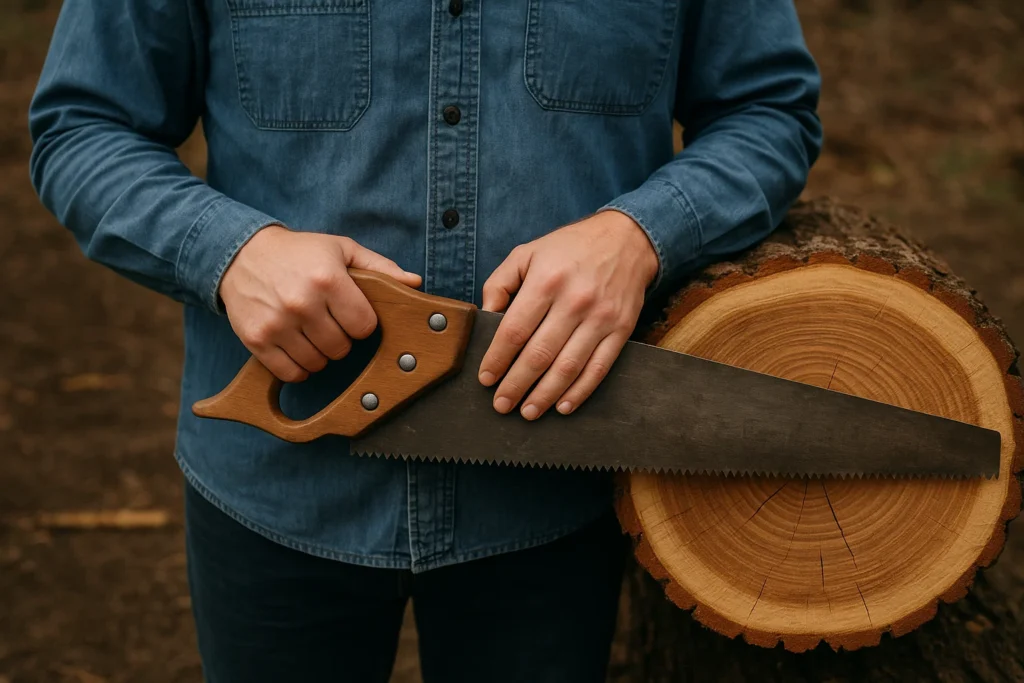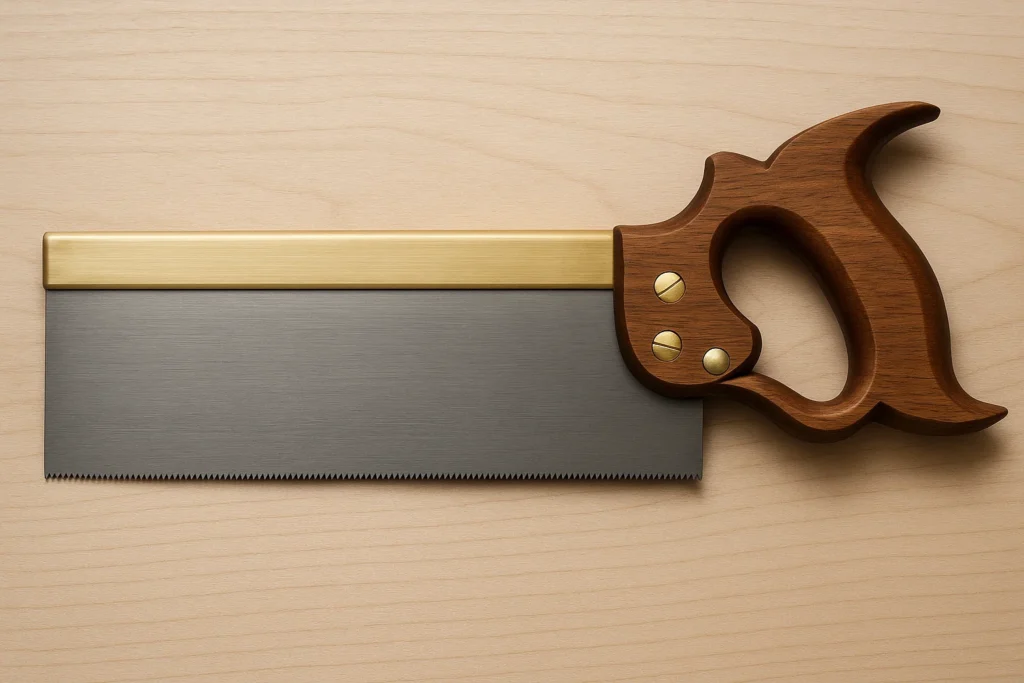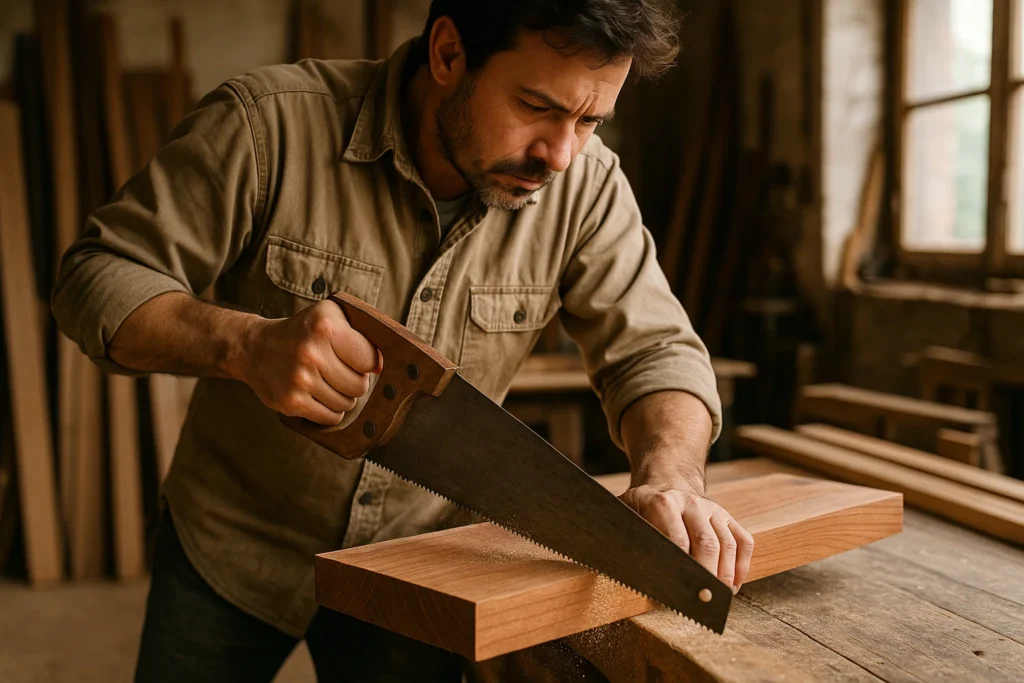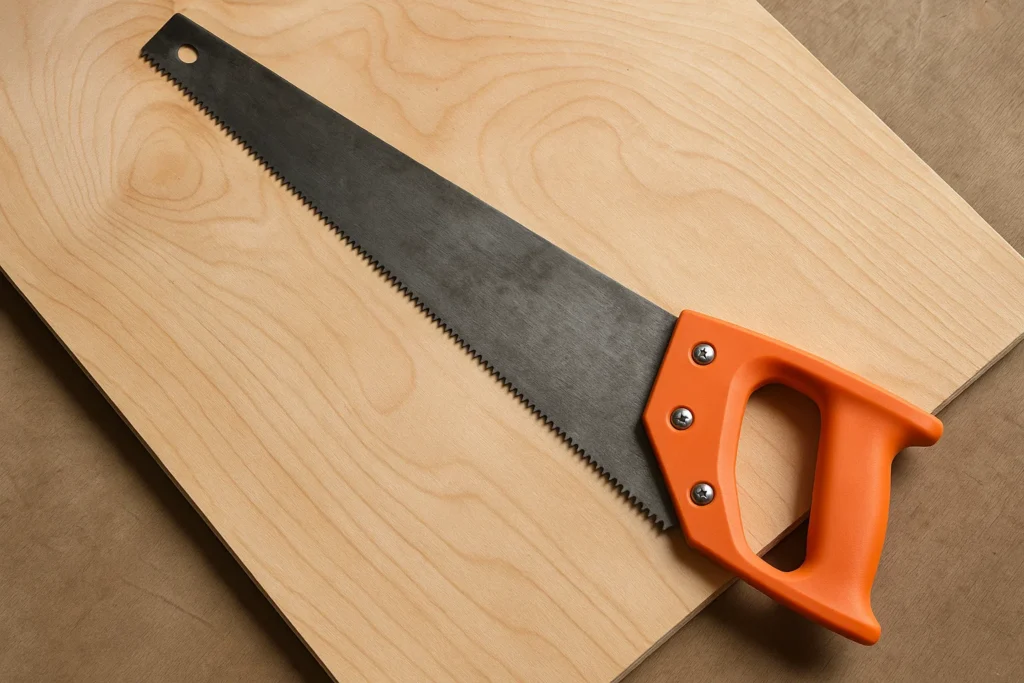Cutting Green Wood Brings Its Own Challenges
Cutting green wood brings its own challenges: sticky sap can clog saw teeth, wet fibers swell and pinch the blade, and uneven hardness slows your progress.
Choosing the wrong saw can mean extra elbow grease, frequent blade clearing, or tools that dull or rust too quickly.
This guide highlights top hand saws designed for fresh, moisture‑rich wood and points out what features really matter—so you can cut cleanly, work safely, and spend less time wrestling with your saw.
Important Points
- Green wood sap sticks to saw teeth and slows cutting
- Use 4–7 TPI saws to clear wet chips fast
- Wide gullets help push out gummy sawdust
- Anti‑rust coatings stop sap from gumming the blade
- Blades need both edge hardness and some flex
- Long blades cut logs; short blades prune branches
- Ergonomic handles cut down hand fatigue
- Proper tooth set keeps the kerf from pinching
- Start cuts with light strokes to guide the blade
- Tap blade every 10 strokes to clear built‑up chips
- Wipe, dry, and oil saw after each use
- File teeth and reset them when cutting feels hard
- Keep steady stroke rhythm for smooth progress
- Tough hardwoods may need power saws or extra prep
- Pick a saw that fits your cutting style and effort level
Some Images are generated by AI for illustration.
Best Hand Saws For Green Wood
Hand Saw | Best For | Blade Length | TPI |
|---|---|---|---|
30″ (762 mm) | 4 TPI | ||
24 ” (610 mm) | 6 TPI | ||
9″ (190 mm) | 7 TPI | ||
20″ (500 mm) | 11 TPI | ||
7.7 in (196 mm) | 7 TPI |
Note: We don’t test products ourselves. Instead, we go through user reviews and/or community discussions to find and recommend the best options.
1. Western Log Saw
A heavy-duty hand saw that cuts green wood fast and straight with the right setup. Best for those who don’t mind a little fine-tuning.
Key Features
- Blade Length: 30″ (762 mm) blade optimized for one-person use
- TPI: 4 TPI provides fast cutting without clogging
- Blade Material: Alloy steel for strength and durability
- Handle Type and Material: Ergonomic wood handhold for secure grip
- Saw Type: Crosscut saw pattern mirrors two-person saw speed
- Cutting Angle / Set: [Not specified]
- Weight: 3 lbs (1.36 kg)
Pros & Cons
Pros:
- Cutting Speed: Fast cutting power like a chainsaw under manual control, slicing through large logs in hours not days
- Sharpness: Sharp out of the box and stays sharp after extended use, reducing need for frequent resharpening
- Tooth Design: Beefy 4 TPI teeth remove plenty of material per stroke for efficient green wood cuts
- Durability: Solid wood handle and sturdy construction ensure long term durability in the field
- Stability: Crosscut tooth pattern and slight blade flex deliver straight, wobble free cuts on varied wood types
- Solo Portability: One‑person 30″ size offers two‑person saw speed with solo portability
Cons:
- Setup Required: Teeth arrive too narrow and coated in poly, requiring hand setting and sanding before peak performance
- Chip Clearing: Lacks rakers for clearing chips, so green wood can bind and clog the blade over time
- Quality Variation: Some units show improper tooth set or surface rust spots straight from the package
- Effort Needed: Manual sawing demands significant elbow grease and is more tiring than a powered alternative
Note: These pros and cons are based on user review trends and latent consensus.
Our Verdict
A rugged manual saw built for tackling green wood with power and precision.
Buy If:
- You need a chainsaw‑like bite without fuel or battery
- You don’t mind tuning teeth and prepping the blade
- You want a straight, wobble‑free cut on thick green timber
- You value a durable, one‑person 30″ saw for camping or forestry
Don’t Buy If:
- You expect perfect performance right out of the box
- You need a self‑clearing blade for very wet wood
- You prefer low‑effort powered alternatives over manual work
Overall, this saw delivers impressive green‑wood cutting once set up properly. It excels for outdoor pros or hobbyists ready to put in a little prep work, but may frustrate anyone seeking a ready‑to‑run tool with zero tuning.
2. Spear & Jackson Traditional
The Spear & Jackson 24″ skew‑back saw gives straight, long cuts in green wood with its rigid high‑carbon blade and brass spine. It costs can be resharpened, though it needs some tuning and handle reshaping.
Key Features
- Blade Length: 24 ” (610 mm) for long, continuous cuts
- TPI: 6 TPI (6 teeth per inch) for rapid stock removal
- Blade Material: High‑carbon steel for edge retention and resharpening
- Handle Type and Material: Wooden handle fixed by rivets for a secure, comfortable grip
- Saw Type: Traditional skew‑back saw for balanced weight distribution
- Cutting Angle / Set: Skew back design for reduced friction and smooth strokes
- Weight: 1.4 lb (0.64 kg) for easy maneuvering
Pros & Cons
Pros:
- Affordability: Great value: high-carbon steel blade and brass spine at a budget price.
- Easy maintenance: Sharpens and resets easily for lifetime use with standard saw files.
- Stability: Rigid blade stays straight under load for accurate cross-cuts in green wood.
- Versatility: Teeth pattern handles both cross-grain and rip-grain cuts after minimal tuning.
- Balance: Weight and length make long cuts feel smooth and controlled.
- Quick cleaning: Lacquer coating wipes clean with acetone, reducing binding in sticky sap woods.
Cons:
- Comfort: Handle is bulky and uncomfortable until reshaped or replaced.
- Prep work: Wide tooth set and rough finish require jointing and reduced set before fine cutting.
- Coating removal: Protective lacquer must be removed before use if you want to prevent gummy buildup.
Quality control: Some saws can arrive with bent plates or inconsistent tooth set.
Fixed design: No quick-change blade options if teeth wear unevenly.
Break-in: May need practice and tuning time before optimal performance on green wood.
Note: These pros and cons are based on user review trends and latent consensus.
Our Verdict
This saw shines once set up, but needs a bit of work first.
Buy If:
- You want a low‑cost, resharpenable saw that lasts decades
- You don’t mind removing lacquer and tuning teeth for cleaner cuts
- You need a stiff blade that holds straight through wet green wood
- You like a well‑balanced length and weight for long cross‑cuts
Don’t Buy If:
- You need perfect out‑of‑the‑box comfort or precision
- You dislike reshaping an oversized handle by hand
- You want quick‑change blades or no‑tune tools
This Spear & Jackson saw is a top pick for green‑wood cutters who enjoy tuning and care about edge life and balance. Budget‑friendly and durable once dialed in, it may frustrate those who need a ready‑to‑go, ultra‑comfortable tool.
3. Bahco Laplander
Compact and durable folding saw with a 9″ (190 mm), 7 TPI Swedish‑steel blade and ergonomic grip, ideal for lightweight green‑wood cutting on the trail. Packs small, locks securely, and resists rust.
Key Features
- Blade Length: 9″ (190 mm) provides reach with precise control
- TPI: 7 TPI enables fast, smooth cuts in green wood
- Blade Material: Swedish steel with rust‑resistant, low‑friction coating ensures durable sharpness
- Handle Type and Material: Folding two‑component plastic handle with leather strap offers secure, non‑slip grip
- Saw Type: Folding saw folds compactly for easy transport
- Cutting Angle / Set: [Not specified] details unavailable
- Weight: 0.44 lb (200 g) minimizes fatigue during extended use
Pros & Cons
Pros:
- Exceptional durability: Blade bends under stress instead of breaking, extending tool life
- Rust‑resistant coating: Low friction finish eases cutting and prevents corrosion
- Dual‑direction cutting: Fore‑and‑back strokes maximize efficiency and reduce effort
- Ergonomic handle: Two‑component grip stays secure in wet or cold conditions
- Compact fold‑and‑lock design: Packs small for easy carry in any backpack or gear pouch
- Versatile performance: Cuts green and dry wood, plastic, and even bone with one saw
- Lightweight at 0.44 lb (200 g): Minimizes user fatigue on long hikes or work sessions
- Great value: Similar durability to high‑end brands at roughly half the price
Cons:
- Blade Flexibility: Blade flexes under sideways pressure, which can affect cutting precision
- Durability on Tough Cuts: Thin blade may bend when pushing through knotty or thicker limbs
- Handle Strength: Plastic handle feels less robust and may crack under very tight grip
- Lock Mechanism Issues: Lock button can be stiff or unreliable in some units
- Replacement Blade Availability: Replacement Laplander blades are hard to find locally [availability varies]
- Cutting Speed: Slower cutting speed compared to premium pull-only saws like Silky models
Note: These pros and cons are based on user review trends and latent consensus.
Our Verdict
Here’s the final verdict.
Buy If:
- You need a compact, lightweight saw for green‑wood cutting on the go
- You value rust resistance and dual‑stroke cutting efficiency
- You want a budget‑friendly tool that holds up under rough use
- You pack light and need a foldable saw that locks securely
Don’t Buy If:
- You routinely cut thick, knotty hardwood requiring fast, aggressive strokes
- You prefer a super‑rigid pull‑only blade for maximum precision
- You need easy local access to replacement blades
- You demand a heavy‑duty handle that won’t flex under high pressure
This folding saw shines as an all‑around bushcraft and camping tool, offering durable, rust‑proof performance in a slim, packable design. However, serious pruning or heavy‑duty hardwood work may call for a stiffer, pull‑only saw with thicker blades.
4. Stanley Jet Cut
The Stanley Jet Cut 20 in hand saw offers a razor‑sharp 11 TPI high‑speed steel blade and ergonomic soft‑grip handle for precise green‑wood cuts, though it benefits from regular drying to prevent surface rust.
Key Features
- Blade Length: 20 in (500 mm) – provides extended reach for deep cuts
- TPI: 11 TPI (teeth per inch) – fine teeth for smooth, precise cuts
- Blade Material: High-speed steel – stays sharp longer for durable performance
- Handle Type and Material: Ergonomic handle with soft-grip inlay – offers comfort and secure control
- Saw Type: Panel saw (hand saw) – ideal for accurate wood cutting
- Cutting Angle / Set: 45° & 90° angle guides – built-in guides for precise angled cuts
- Weight: 1.04 lb (0.47 kg) – lightweight design reduces user fatigue
Pros & Cons
Pros:
- Effortless cutting: Extremely sharp blade glides through wood with minimal force for fast, clean cuts.
- Comfortable grip: Soft‑inlay handle reduces hand fatigue during extended work sessions.
- Long‑term reliability: Holds up to years of use without losing core performance.
- Precise angle guidance: Built‑in 45° and 90° markers help maintain straight cuts without extra tools.
- Versatile use: Fine 11 TPI blade handles both cross‑grain and rip cuts smoothly.
- Lightweight design: At just over 1 lb (0.47 kg), it’s easy to maneuver in tight or awkward spots.
Cons:
- Rust prone: Blade shows surface rust quickly if not dried and stored properly.
- Dulls under heavy use: Fine teeth lose sharpness faster with continuous cutting.
- Stability issues: Some units exhibit blade wobble or loosening at low load.
- Quality variance: Occasional damaged teeth or loose screws out of the box.
- Packaging risks: Tight fit in cardboard can bend or twist the blade on delivery.
Note: These pros and cons are based on user review trends and latent consensus.
Our Verdict
Here’s the bottom line.
Buy If:
- You need a very sharp blade for clean green‑wood cuts
- You want a lightweight saw that’s easy to handle
- You like built‑in 45° and 90° angle guides
- You do light to medium garden or workshop tasks
- You value quick, accurate cross‑grain and rip cuts
Don’t Buy If:
- You need a saw for heavy, continuous professional use
- You often work in damp conditions without drying gear
- You require absolutely zero blade wobble under load
- You prefer a replaceable blade over a fixed one
This saw shines for hobbyists and light pros cutting green wood, thanks to its sharpness, comfort, and angle guides. If you need rugged, all‑day reliability or worry about rust, consider a more heavy‑duty model.
5. FLORA GAURD
Portable folding SK‑5 saw with triple‑cut coarse teeth that power through green wood—ideal for camping or garden tasks. Compact and sharp, though plastic handle and hinge may limit heavy‑duty longevity.
Key Features
- Blade Length: 7.7 in (196 mm) [10 in (254 mm) version also offered]
- TPI: 7 TPI for efficient cutting of small‑to‑medium branches
- Blade Material: SK‑5 high‑carbon steel with anti‑rust coating
- Handle Type and Material: Ergonomic curved folding polymer handle with rubberized grip
- Saw Type: Curved folding pruning saw
- Cutting Set: Triple‑cut razor teeth for fast coarse‑wood cutting [specific tooth angle not provided]
- Weight: 0.99lb (0.45kg)
Pros & Cons
Pros:
- Compact Portability: Folds down small for belt or pack carry, perfect for camping and on‑the‑go pruning.
- Fast, Sharp Cutting: Triple‑cut razor teeth slice through green and wet branches with minimal effort.
- Built‑In Safety: Folding guard and positive lock keep the blade secure during use and transport.
- Tool‑Free Ready: No assembly required—ready to use straight out of the box.
- Chainsaw Alternative: Handles small‑to‑medium limbs cleanly without the bulk, noise, or maintenance of power tools.
- Lightweight Handling: Easy to swing for extended periods, reducing hand and arm fatigue.
Cons:
- Durability Concerns: Handle and hinge pin have been reported to break or work loose after minimal use.
- Blade Retention: Straight pivot pin lacks flared edges, allowing the blade to shift or fold unexpectedly under load.
- Less Fine Control: Coarse 7 TPI teeth can struggle on very small or delicate branches.
- Build Quality: Plastic handle components feel cheap and may crack over time.
- Weight Unspecified: Exact weight not provided—some users noted it felt heavier than anticipated.
Note: These pros and cons are based on user review trends and latent consensus.
Our Verdict
Whether you’re tackling fresh green wood on the trail or tidying up sap‑rich branches at home, here’s when to choose (or skip) this folding pruning saw.
Buy If:
- You need a lightweight, pack‑able saw for camping or survival kits
- You want razor‑sharp, coarse teeth that power through wet green limbs
- You value a quick‑deploy, tool‑free blade with a reliable safety lock
- You prefer a chainsaw‑alternative for small‑to‑medium branches
Don’t Buy If:
- You demand heavy‑duty durability for frequent or rugged use
- You need precise, fine‑tooth cutting on small or delicate shoots
- You’re concerned about plastic handle or hinge longevity
- You dislike potential blade play or pin loosening under load
This folding hand saw excels at fast, coarse‑wood cutting and ultra‑portable convenience, making it a great pick for green‑wood tasks in the field or garden. However, if you require long‑term robustness or ultra‑fine cutting control, you may want a more heavy‑duty alternative.
Why Green Wood Is Unique
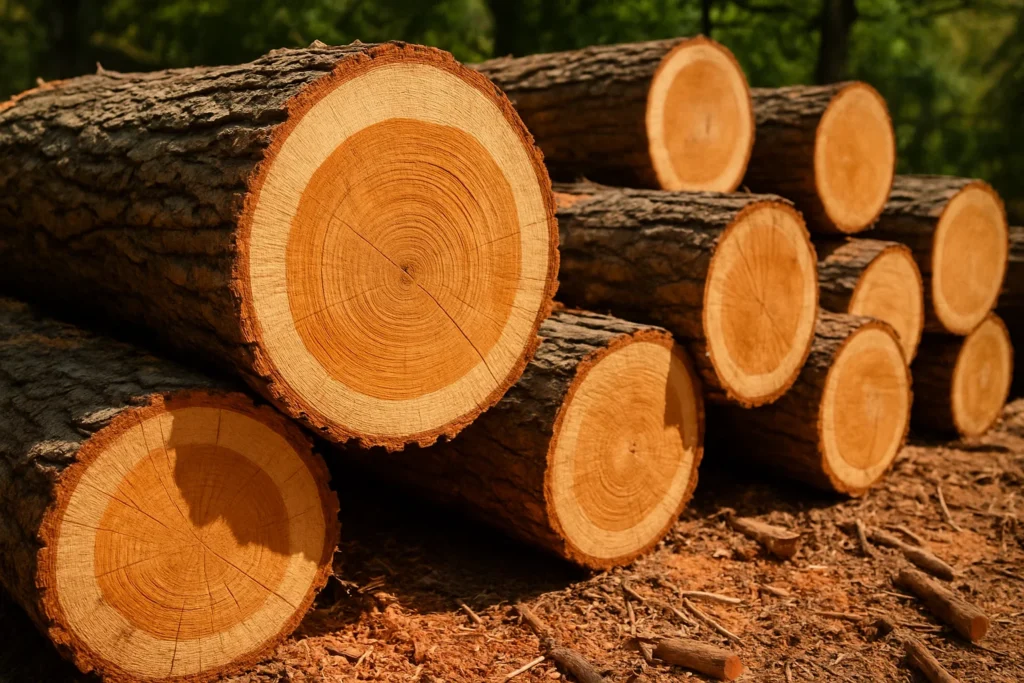
Green (freshly cut) wood behaves very differently from dry wood, and understanding those differences is key to choosing the right saw.
1. High Moisture Content (Gummy Cuts)
Living trees can be 50 %–60 % water by weight. When you saw, wet fibers and sap smear against the blade, clogging gullets and teeth.
A clogged blade stalls, requires more effort, and leaves rough cuts that tear rather than slice.
2. Fiber Direction & Binding
Green wood fibers run in different directions—along the grain (longitudinal) and around the growth rings (radial/tangential).
As you cut, the cut kerf can pinch the blade because wet fibers swell and press inward. If the blade binds, it stalls or bends.
3. Variable Hardness & Density
The outer, wetter sapwood is softer but extra gummy; the inner heartwood is firmer but may still grip the blade.
You’ll feel the saw speed change as you move through zones—adjust your stroke to avoid sudden binding or chatter.
4. Heat & Friction Build‑Up
Clogged teeth generate heat, which softens any coating and accelerates wear.
A blade designed with self‑cleaning gullets and aggressive tooth geometry clears sawdust and sap, keeping friction low.
Key Saw Features for Green Wood
Choosing a saw for green wood means looking beyond “any blade will do.” You need features that handle moisture, resin, swelling fibers, and variable resistance. Below, each critical attribute is broken down so you know exactly what to look for—and why.
1. Tooth Geometry
Aggressive rake angle:
- What it is: The angle at which teeth bite into the wood. A steeper (more “raking”) angle slices deeper each stroke.
- Why it helps: Deep gullets evacuate wet chips quickly, preventing clogging. If you’ve ever stopped sawing to knock sap off the blade, a steeper rake does that for you.
Gullet size and shape:
- What it is: The curved space behind each tooth that holds sawdust.
- Why it helps: Wide, self‑cleaning gullets let wet shavings flow out. Narrow gullets fill up fast and trap gummy residue.
Teeth Per Inch (TPI):
- Range for green wood: 4–7 TPI is ideal.
- Why: Low TPI (few, large teeth) clears chips faster; too fine and you stall in sap. If you’ve struggled with a fine‑tooth saw on fresh limb, it’s because the gullets weren’t big enough.
2. Blade Material & Coating
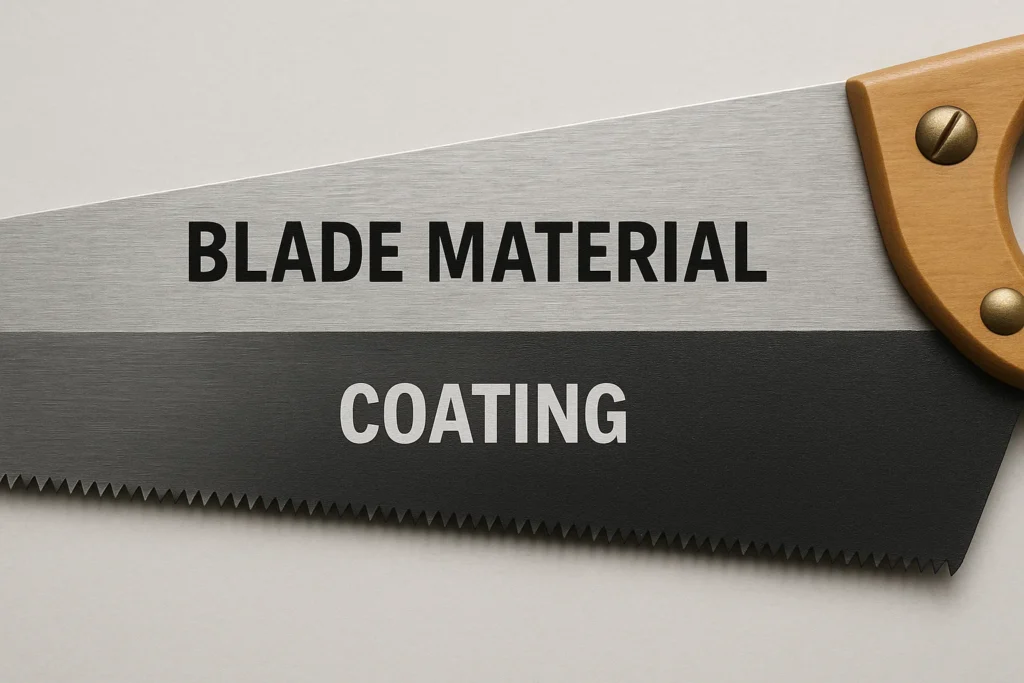
Material | Pros | Cons |
|---|---|---|
High-carbon | Stays sharp longer in abrasive sap | Can rust without coating |
Spring steel | Flexible—resists bending or chipping | Softer—dulls faster in grit |
Anti‑corrosion coatings:
- Common types: Teflon, phosphating, or black oxide.
- Benefit: Keeps sap and water from bonding to the blade surface. You’ll notice less sticky buildup, and strokes stay smooth.
Hardness vs. flexibility:
- What to look for: A balance—blade that can flex (avoid breakage in binding) but holds an edge.
- Tip: Many green‑wood saws specify Rockwell hardness around 50–55 HRC. If you see that spec, you know it’s tuned for damp, gummy conditions.
3. Blade Length & Profile

Blade length:
- Short blades (12–18 in):
- Best for tight work—pruning, branch‑by‑branch cuts.
- Easier to control on uneven surfaces.
- Long blades (20–36 in):
- Ideal for straight, long cuts in logs or billets.
- Fewer strokes needed—greater efficiency.
Blade profile:
- Straight blade:
- Consistent depth; great for cross‑cutting logs on sawhorses.
- Curved blade:
- Natural slicing motion—excellent for pruning high or awkward angles.
- Curve keeps all teeth engaged, even on small branches.
Kerf width:
- Thin kerf (≤0.035 in): Less drag and faster cutting.
- Trade‑off: Too thin can bend or bind if fibers swell excessively.
4. Handle Design & Comfort
Ergonomic grip shape:
- Why it matters: Wet wood increases vibration; a contoured handle reduces hand fatigue.
- Look for: Rounded, palm‑filling designs with a thumb rest.
Material & finish:
- Rubber or textured wood: Improves grip when your hands—or the tool—get wet.
- Avoid: Smooth plastic that slips under pressure.
Handle‑to‑blade angle:
- Optimal range: 10°–15° offset keeps your wrist in a neutral position, so you can apply steady pressure without strain.
5. Tooth Set & Taper
Tooth set:
- What it is: The outward bend of each tooth.
- Green‑wood spec: Moderate set to create a kerf slightly wider than the blade, preventing pinching as fibers expand.
Blade taper:
- Tapered blades thin toward the spine, reducing binding by keeping more sawdust space and lowering friction.
Cutting Techniques
Efficient, clean cuts in green wood aren’t just about the saw—you need a technique that keeps moisture, swelling fibers, and sap from slowing you down.
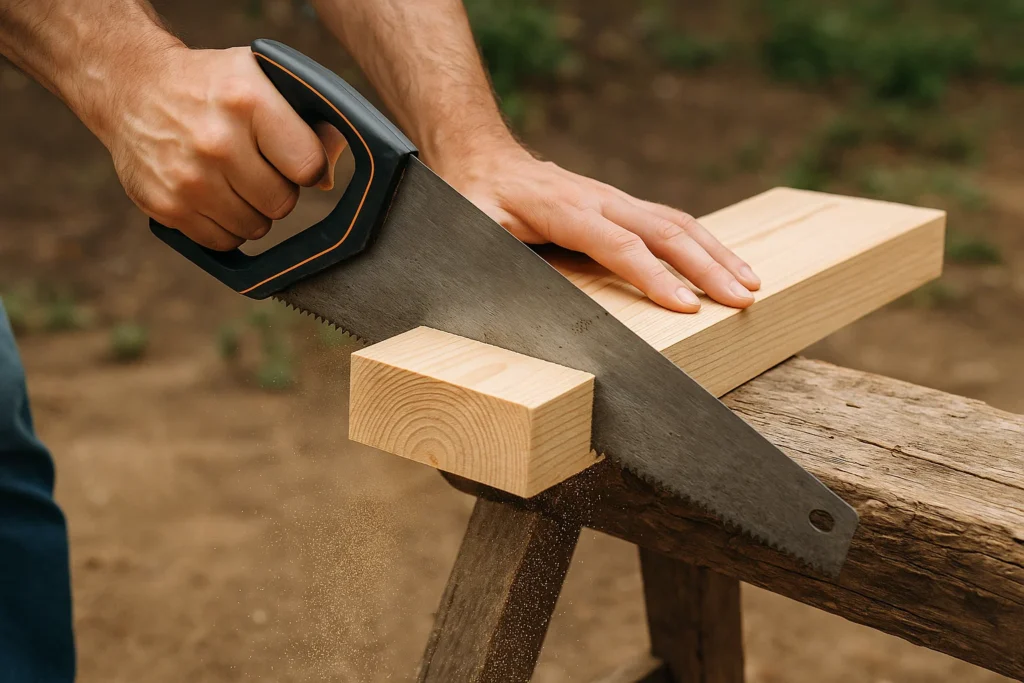
1. Establishing the Kerf
Draw your cut line and clamp or secure the workpiece. A wobble-free start prevents binding.
Begin with light, short pulls to score the wood. This “guide groove” keeps the blade on track without grabbing too much wet fiber at once.
2. Consistent Stroke Rhythm
Push or pull the blade through its entire length on each stroke. Short chops pack sawdust and sap into the gullets.
A brisk but controlled tempo lets the gullets clear naturally. Rushing forces gummy chips against the blade, stalling progress.
3. Managing Sap & Debris
Every 10–15 strokes, pause and tap the blade edge on scrap wood or knock gently against your boot. This dislodges built‑up shavings.
Angle slightly downward on return strokes so gravity helps shed wet chips.
4. Pressure & Body Mechanics
Apply just enough forward force for the teeth to engage. Over‑pressing bends the blade and accelerates clogging.
Stand with feet shoulder‑width apart, facing the cut. Alternate hand grips gently—your lead hand guides, your rear hand supplies power.
5. Adjusting on the Fly
If the blade veers, stop and realign rather than forcing the correction mid‑cut.
If you feel a stall, ease pressure, clear the saw, then resume with lighter strokes.
Maintenance & Sharpening
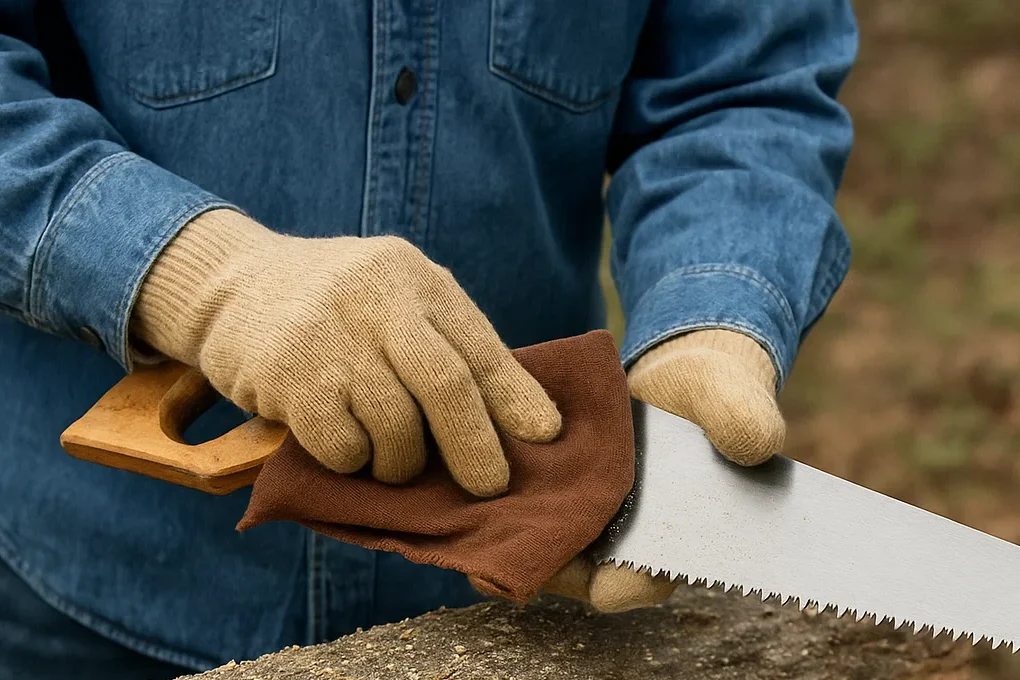
Keeping your green‑wood saw in top shape means regular cleaning, timely sharpening, and correct tooth‑setting. This prevents gummy buildup, keeps cuts smooth, and extends blade life.
1. Cleaning After Each Use
- Remove sap and debris: Wipe the blade with a rag soaked in mineral spirits or denatured alcohol. This dissolves sticky resin rather than smearing it.
- Dry thoroughly: Any lingering moisture invites rust. After solvent cleaning, buff dry with a clean cloth.
- Light oil coating: Apply a thin film of light machine oil (e.g., 3-in-1) to inhibit corrosion and repel sap.
2. Sharpening Tools & Technique
- Triangular saw file: Match file size to your saw’s tooth spacing (e.g., 4 TPI needs a larger file than 7 TPI).
- Gullet raker (hook file): Clears waste between teeth without altering tooth angle.
- Procedure:
- Secure the blade flat in a vise.
- File every other tooth on one side, using smooth, even strokes at the original rake angle.
- Flip blade, repeat on remaining teeth.
- Use the gullet raker to open any clogged gullets, preserving gullet shape.
3. When to Re‑set Teeth
- Signs teeth need setting: Blade binds or makes ridged cuts despite sharp edges.
- Tool: Use a saw‑set that matches your saw’s thickness.
- Goal: Create a uniform kerf about 0.02–0.03 in wider than the blade—just enough to prevent binding without wasting wood.
Common Pitfalls & Troubleshooting
Even the best green‑wood saw can run into issues. Here’s how to recognize and fix them fast.
1. Blade Binding
- Symptom: Progress stalls mid‑cut, blade pinches.
- Cause: Swollen fibers closing the kerf.
- Fix: Ease pressure, clear chips, then resume with lighter, full‑length strokes. If binding persists, reset teeth for a slightly wider kerf.
2. Excessive Wear or Dulling
- Symptom: Sawdust turns powdery; teeth skid rather than bite.
- Cause: Grit, sap abrasion, or too‑fine TPI.
- Fix: Sharpen with the correct file size at the original rake angle. If you grind off too much metal, consider replacing the blade.
3. Gummy Residue Buildup
- Symptom: Sap clogs gullets; you have to stop and clear frequently.
- Cause: Lack of coating or infrequent cleaning.
- Fix: After cleaning per section 6, apply a thin Teflon or light‑oil film before use. Mid‑cut, tap the blade on scrap wood every 10 strokes.
4. Chattering or Rough Cuts
- Symptom: Jagged edges or blade vibration.
- Cause: Loose handle, incorrect blade tension (in frame saws), or uneven tooth set.
- Fix: Tighten handle screws or frame tension; inspect and uniformize tooth set.
Final Thoughts
Cutting green wood demands more than just any saw—it requires the right tooth design, blade material, and handle comfort to deal with moisture, sap, and swelling fibers.
Whether you need portability for bushcraft, precision for garden work, or raw power for logs, each saw here offers something unique.
Choose the one that fits your cutting style, prep expectations, and workload—and you’ll spend less time fighting the wood and more time getting the job done.
If you see any kind of mistake in our content, make sure to reach out to us.
You May Also Like
Find the best hand saw for miter cuts!
Making Furniture? Here are the best hand saws!
Frequently Asked Questions (FAQs)
What is the best saw blade for green wood?
A blade with low to medium tooth count (4–7 TPI), steep rake angle, and a self‑cleaning gullet works best. Look for high‑carbon or spring steel with an anti‑rust coating. This combination clears wet chips quickly and resists binding.
Which saw is best for trees?
Powered option: Chainsaw for fast, heavy cuts on large trunks.
Manual option: Bow saw or two‑person crosscut saw (e.g. Western Log Saw) for big limbs and logs when no power is available.
Is green wood harder to cut?
Green wood is softer in the fibers but contains high moisture and sap. That sap gums up fine teeth and can pinch the blade, so you may need more elbow grease and frequent clearing—even though the wood itself is less dense than dry wood.
What is green wood good for?
- Carving & turning: Easier to shape with hand tools or lathes.
- Steam bending: Moist fibers bend without cracking.
- Firewood: Burns hot and fast when seasoned.
- Garden stakes & fence posts: Cuts easily and holds nails or rope well.
What is the hardest wood to cut?
Dense tropical hardwoods top the list. Examples include:
- Lignum vitae – extremely heavy and oily.
- Ipe (Brazilian walnut) – very dense with interlocked grain.
- Ebony – fine, interlocked grain that dulls blades fast.
These woods demand robust blades, frequent sharpening, and more effort to saw.
The Grain Bros was started to serve woodworkers who can’t find products for their specific use case. We found out that there are not many media outlets extensively covering this topic. That’s why, we are here, to do the research and find the perfect products for your next DIY project. So you don’t have to juggle your tools and laptop at the same time.
If you see any kind of mistake in our content, make sure to reach out to us.

